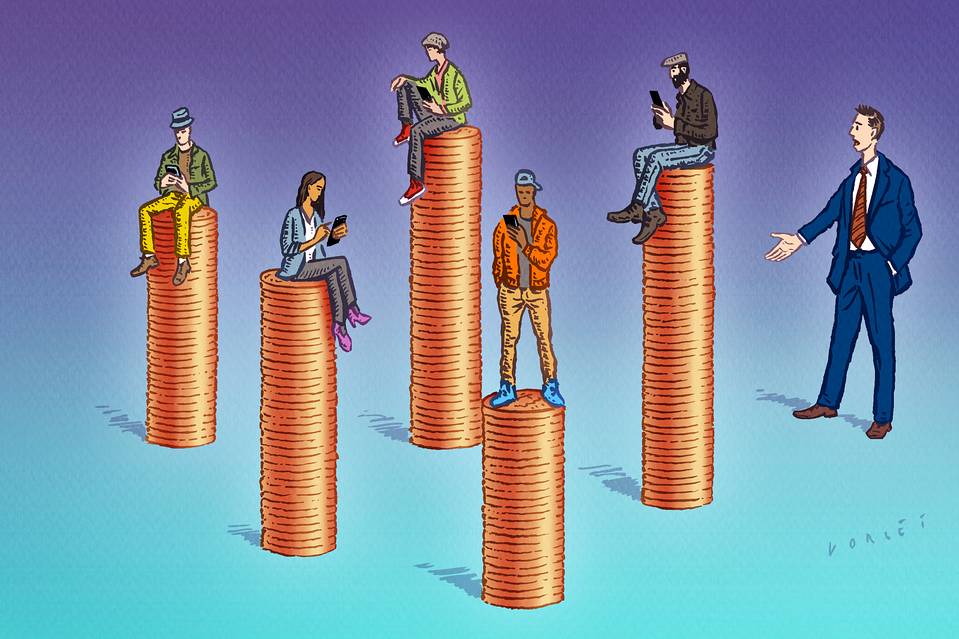Inertia? Impulsivity? New smartphone apps can turn such vices into virtues…
The young and the poor used to have to pinch their pennies for years to scrounge up enough money to invest. Now, thanks to the smartphone, their pennies are enough.
Clever new smartphone applications turn two human vices — inertia and impulsivity — into virtues. Technology is putting saving and investing, which traditionally lay beyond the reach of millions of Americans, within anyone’s grasp. As a result, the democratization of markets begun by mutual funds and discount brokerages may still have room to run.
Stash, an app that lets investors start buying miniaturized portfolios of exchange-traded funds with as little as $5, started in October 2015. Stash is up to approximately 420,000 customers, with 3,000 new accounts opening daily, says co-founder Ed Robinson.
The first three months are free; after that, Stash costs $1 per month. Its typical investor starts with roughly $40 and adds about $20 per week, Mr. Robinson says.
Acorns, another micro-investing app, had 850,000 accounts last April. It has more than 1.4 million now, having opened 125,000 new accounts in January alone, says chief executive Noah Kerner. Acorns also charges $1 per month.
Once customers connect debit or credit cards to their account, Acorns “rounds up” their purchases to the nearest dollar, investing the difference. That turns investing from a forehead-furrowing effort into an automatic occurrence “in the background of life,” says Mr. Kerner.
For the smallest accounts at these firms, costs are big. Invest only $5, and that $1 fee eats 20% of your account. A $50 balance incurs costs of 2%. By $500, however, fees fall to a reasonable 0.2%.
But you can’t invest if you don’t first save. That has been a daunting obstacle for many Americans.
A survey by the Federal Reserve Board of more than 5,600 people in late 2015 found that 46% said they didn’t have enough savings to cover a $400 emergency expense without either borrowing money or selling something.
A book to be published in April, “The Financial Diaries,” by economist Jonathan Morduch and nonprofit executive Rachel Schneider, shows that household income can vary by 40% or more from month to month — and not just for the poor. Many people severely underestimate the variability in their own earnings.
That’s where an app like Digit could help. Once you connect Digit to your checking account, the service analyzes your spending and income.
Leaving margin for error, “Digit tries to find the perfect amount you should save,” says chief executive Ethan Bloch, “money that you don’t need to spend and that you won’t feel you’re missing.”
The service then moves that amount to your savings account every few days. If Digit causes an overdraft, it refunds any fees.
Digit doesn’t reveal how many customers it has, but Mr. Bloch says their combined balances exceed $350 million.
“Digit saves more at certain times and less at others,” says Jenn Chen, a 29-year-old marketing manager in the San Francisco area. “I kind of let it do its thing, knowing it’s just running in the background.”
Qapital, another savings app, has 130,000 users who are saving an average of about $160 per month. Users can design their own rules or objectives, and Qapital will round up their purchases to fund those targets.
Trying to meet their goals turns saving into a game for “the strugglers” who have never been able to set money aside before, says Qapital’s chief executive, George Friedman.
Hoping to hit the jackpot can help, too.
Long Game, a smartphone app that launched in November, was co-founded by Ashby Monk, a researcher at Stanford University who advises pension and sovereign-wealth funds controlling trillions of dollars. Long Game’s typical user, on the other hand, opens an account with only about $60.
Save with Long Game and you become eligible to participate in sweepstakes with prizes of up to $1 million. Deposits are covered by the Federal Deposit Insurance Corp. The sweepstakes drawings are permitted under a federal law passed in 2014.
The app has over 12,000 users and is growing by more than 2,000 per week, says co-founder Lindsay Holden. The average saver, she says, adds an average of about $52 per month.
Scott Libby, 18, is a college-bound high-school senior in the Nashville, Tenn., area. He says he began using Long Game on Dec. 26 and, as of this past week, had saved $616.63. That includes earnings from his job at a coffee shop, plus a total of $101.40 he has won in six prize drawings — in increments ranging from 10 cents to $100.
Mr. Libby withdrew his $100 win, although he hasn’t spent it yet. “Even the 10 cents,” he says, “keeps you going with your saving.”
He adds, “It’s somewhat addicting. It’s like a lottery but with no chance of losing money.”
Most readers of The Wall Street Journal probably don’t struggle to save. But millions of people do — some of them, perhaps, among your own family and friends. Technology might be able to help them accomplish what willpower can’t.

